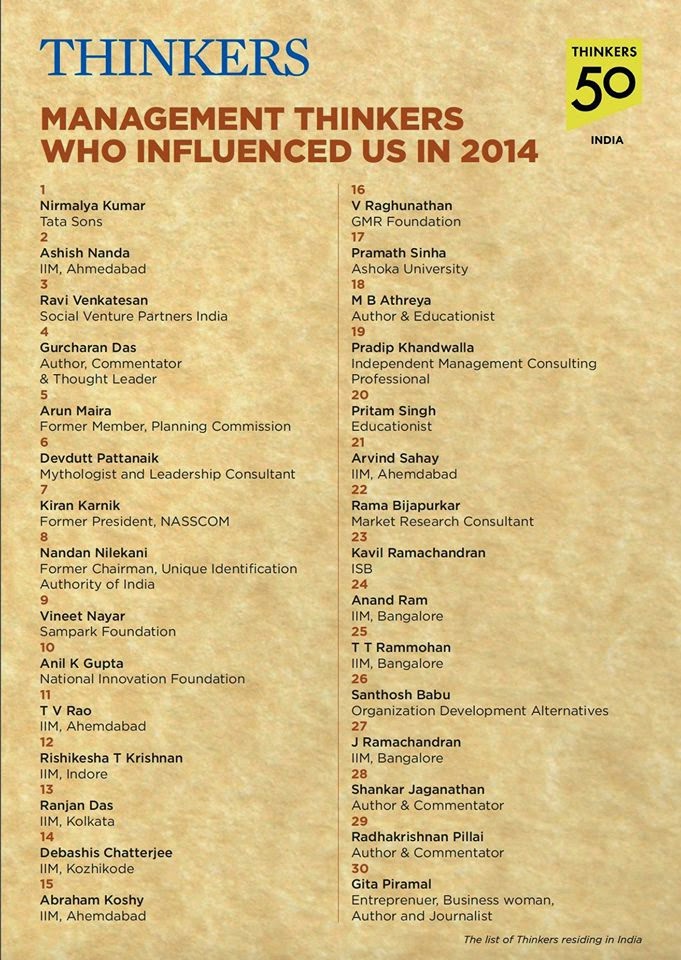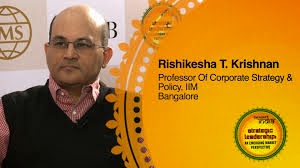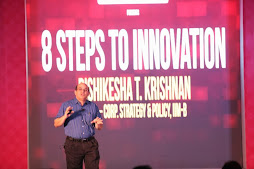This year I had multiple opportunities to speak to doctoral
students and faculty at some of our leading institutions. IIM Rohtak had
organized an internal Faculty Development Workshop; IIM Ahmedabad invited me to
speak to their new cohort of doctoral students; and we had our own Faculty
Development Programme (see picture below) as well as the Conference for
Excellence in Research & Education (CERE) at IIM Indore.
Through this blog, I want to share the perspective I
presented to these groups.
First, here’s a quiz question. Who are the five people in
the picture below?
Anil Gupta is arguably the foremost evangelist of grassroot
innovators in developing countries. He has spent the last twenty years
documenting their innovations and recognizing the innovators.
Raghunath Mashelkar has had a distinguished career as a
scientist and engineer. He led the National Chemical Laboratory with great
distinction and later, as Director General of CSIR, raised national awareness
of intellectual property rights.
Arogyaswami Paulraj developed the first indigenous sonar for
the Indian Navy and later set up the Central Research Laboratory for Bharat
Electronics Ltd. He moved to Stanford after taking early retirement from the
navy, and is today credited with being one of the inventors of MIMO technology,
a critical part of the backbone for 4G wireless systems.
Manindra Agarwal and two of his students at IIT Kanpur
developed an algorithm that works in polynomial time to determine whether a
number is prime. They thereby solved a problem that had defied mathematicians
for years.
Ramachandra Guha is today India’s leading modern historian
apart from being an acclaimed columnist and writer about cricket.
What’s common between Anil Gupta, Mashelkar, Paulraj,
Manindra and Ram Guha?
For one, of course, they have all been very successful in
their chosen fields and received international acclaim. But they have one
common characteristic – they all received their PhDs from India, and all of
them made their primary intellectual contribution working in India.
It is possible to work in India and do world class
intellectual work. We saw another example of this in my previous post on Prof.
J. Ramachandran.
So, what do we need to do if we want to emulate any of these
successful scholars?
I suggest the following 5-point Agenda:
View Yourself as More than a Teacher
The first important thing is to view oneself as more than a
teacher. Ideally, one should see oneself as an engaged scholar who moves
seamlessly between creating new knowledge and disseminating it. One has to see
research and knowledge creation as core, not as an additional chore. In the
management sphere, it is important to straddle conceptual strength, rigour and
relevance in any such research one undertakes. See my earlier post on Prof. J.
Ramachandran for some insights into how to do this.
Focus & Strategic Intent
The second (and probably equally important to the first)
thing is to focus. With the explosion of knowledge today, it is unlikely that
one can become an outstanding scholar in multiple areas. Instead, one should
choose any one area that has potential impact and dig into that area.
Becoming an acclaimed scholar is a marathon and not a
sprint, so one should be willing to be in it for at least the next 5 years,
probably even more. Along with focus, one should ideally have a strategic
intent to be the best scholar in that (sub-) field of choice and be willing to
work hard towards that. Aligning one’s teaching to the focus area to the extent
possible would help one synergise different activities.
Of course, if one has a choice, one should be careful in
choosing the institution where one works. The key question is, “does the
institution support the development of engaged scholars?” Does it allow the
time and space, and provide the infrastructural as well as intellectual support
to promote such development?
Benchmark against the Best
The third important requirement is to benchmark against the
best. Today, Indian institutions may not expect the same quantity and quality
of research output as established institutions abroad do. But, to become a
well-accepted global scholar, one should take on the same standards as would be
expected by a top institution anywhere. For example, a young assistant
professor entering an IIM should benchmark herself against the tenure
requirements of a top US school.
Continuous Improvement
Becoming an acclaimed scholar will involve considerable
stretch. While the aspiration or strategic intent to become one might provide
the energy and push to get there, the mechanics of reaching there are still
important.
I have been impressed by the idea of deliberate practice.
Research on high performing sportsmen and performers shows that they have put
in more than 10,000 hours of practice before they reach the pinnacle of their
discipline. But, just spending 10,000 hours is not enough – these 10,000 hours
need to be spent on continuous improvement, often driven by a coach or mentor
who can identify one’s weaknesses and help one iron them out.
This idea of continuous practice can be applied to
scholarship as well: take on more difficult research problems, reach out to
higher quality publication outlets, and strive to enhance one’s teacher ratings
based on feedback.
Having a good mentor is invaluable in this process.
Unfortunately, there are not enough good mentors around in India, so one might
have to reach out to established scholars in other parts of the world.
Fortunately, there are many scholars of Indian origin all over the world who
are willing to help.
Manage your time Judiciously
Last, but certainly not the least, is good time management.
I have already emphasized focus and aligning one’s teaching and research to the
extent possible. As a young professor, everything looks interesting, but it is
imperative to be focused and avoid getting into activities that distract from
good scholarship. If one has a choice, its good to stay away from routine
academic administration at least in the formative years. I would suggest doing
the minimum required to be a good organizational citizen, but otherwise staying
away from tasks that distract one from the main mission of scholarship.
Tailpiece
As I mentioned earlier, institutional support is important
for an individual scholar to make his mark. What should be the institutional
agenda to support such individual scholarship? That will be the subject of one
of my next posts!
[The views expressed here are the personal views of the
author.]








































